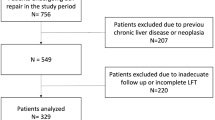Abstract
Early identification of patients likely to deteriorate post-hepatic portoenterostomy for biliary atresia (BA) would be beneficial. α-Glutathione-s-transferase (α-GST) is a serologic marker of reactive hepatocellular damage because of its low molecular weight, uniform hepatic distribution, high cytosol concentration, and short half-life. We evaluated whether serum α-GST in post-surgical BA patients correlates with liver function (LF) and investigated its potential as a medium- to long-term marker of prognosis. Postoperative BA patients (n = 30; mean age: 11.8 ± 3.7 years) were divided into three groups based on average LF over the 3 months prior to this study. Group I (n = 8) were jaundice-free and had normal LF. Group II (n = 12) had moderate liver dysfunction, and group III (n = 10) had severe liver dysfunction. Serum α-GST was determined using a specific ELISA. Tissue α-GST was determined immunohistochemically, using liver needle-biopsy specimens. Bile lakes were found in 5 group II patients and 5 group III patients. Serum α-GST was significantly higher in group II (20.7 ± 8.4 ng/ml) than in groups I (4.7 ± 1.3 ng/ml) and III (8.0 ± 1.2 ng/ml) (P < 0.0001) and was highest in group II subjects with bile lakes. In control liver specimens α-GST distribution was weak but uniform throughout normal liver lobule hepatocytes. In group II there was strong staining in centrilobular hepatocytes, and in group III α-GST was only found in regenerative nodules. We conclude that α-GST may be a more sensitive indicator of hepatocellular damage in BA because its distribution is correlated to the proportion of functioning liver tissue present. This is the first report of this relationship, which has great implications for group II subjects because a sudden shift in concentration of α-GST may be a better predictor of impending hepatic dysfunction than conventional LF tests.
Similar content being viewed by others
Author information
Authors and Affiliations
Rights and permissions
About this article
Cite this article
Kobayashi, H., Horikoshi, K., Yamataka, A. et al. α-Glutathione-s-transferase as a new sensitive marker of hepatocellular damage in biliary atresia. Pediatr Surg Int 16, 302–305 (2000). https://doi.org/10.1007/s003830050749
Issue Date:
DOI: https://doi.org/10.1007/s003830050749




